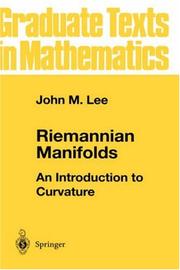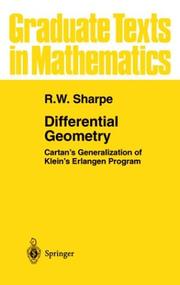| Listing 1 - 3 of 3 |
Sort by
|
Book
ISBN: 2841340015 Year: 1997 Publisher: Paris New York : Diderot,
Abstract | Keywords | Export | Availability | Bookmark
 Loading...
Loading...Choose an application
- Reference Manager
- EndNote
- RefWorks (Direct export to RefWorks)

ISBN: 038798271X 0387983228 0387227261 1280010142 9786610010141 9780387983226 Year: 1997 Volume: 176 Publisher: New York : Springer,
Abstract | Keywords | Export | Availability | Bookmark
 Loading...
Loading...Choose an application
- Reference Manager
- EndNote
- RefWorks (Direct export to RefWorks)
This book is designed as a textbook for a one-quarter or one-semester graduate course on Riemannian geometry, for students who are familiar with topological and differentiable manifolds. It focuses on developing an intimate acquaintance with the geometric meaning of curvature. In so doing, it introduces and demonstrates the uses of all the main technical tools needed for a careful study of Riemannian manifolds. The author has selected a set of topics that can reasonably be covered in ten to fifteen weeks, instead of making any attempt to provide an encyclopedic treatment of the subject. The book begins with a careful treatment of the machinery of metrics, connections, and geodesics,without which one cannot claim to be doing Riemannian geometry. It then introduces the Riemann curvature tensor, and quickly moves on to submanifold theory in order to give the curvature tensor a concrete quantitative interpretation. From then on, all efforts are bent toward proving the four most fundamental theorems relating curvature and topology: the Gauss–Bonnet theorem (expressing the total curvature of a surface in term so fits topological type), the Cartan–Hadamard theorem (restricting the topology of manifolds of nonpositive curvature), Bonnet’s theorem (giving analogous restrictions on manifolds of strictly positive curvature), and a special case of the Cartan–Ambrose–Hicks theorem (characterizing manifolds of constant curvature). Many other results and techniques might reasonably claim a place in an introductory Riemannian geometry course, but could not be included due to time constraints.
Riemannian manifolds --- Riemann, Variétés de --- Mathematics --- Global differential geometry --- Riemannian manifolds. --- Geometry --- Physical Sciences & Mathematics --- 514.764.2 --- Riemannian and pseudo-Riemannian spaces --- 514.764.2 Riemannian and pseudo-Riemannian spaces --- Riemann, Variétés de --- EPUB-LIV-FT SPRINGER-B --- Mathematics. --- Differential geometry. --- Differential Geometry. --- Manifolds, Riemannian --- Riemannian space --- Space, Riemannian --- Geometry, Differential --- Manifolds (Mathematics) --- Global differential geometry. --- Differential geometry

ISBN: 9780387947327 0387947329 3540947329 Year: 1997 Publisher: New York, NY : Springer,
Abstract | Keywords | Export | Availability | Bookmark
 Loading...
Loading...Choose an application
- Reference Manager
- EndNote
- RefWorks (Direct export to RefWorks)
Geometry, Differential --- Géométrie différentielle --- 514.76 --- Differential geometry --- Geometry of differentiable manifolds and of their submanifolds --- Geometry, Differential. --- 514.76 Geometry of differentiable manifolds and of their submanifolds --- Géométrie différentielle --- Global differential geometry --- Géométrie différentielle globale --- Connections (Mathematics) --- Connexions (mathématiques) --- Global differential geometry. --- Géométrie différentielle globale. --- Geometrie differentielle locale et globale --- Geometrie differentielle classique --- Geometrie differentielle projective --- Varietes riemanniennes
| Listing 1 - 3 of 3 |
Sort by
|

 Search
Search Feedback
Feedback About UniCat
About UniCat  Help
Help News
News